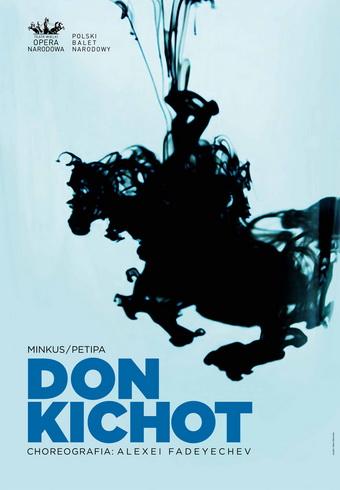
Poster designed by Adam Żebrowski.
On Thursday, 29 May 2014 Teatr Wielki ? Polish National Opera is presenting the Polish National Ballet?s last premiere of this year ? Don Quixote set to Marius Petipa?s libretto based on the novel by Miguel de Cerantes. Don Quixote returns to the PBN?s repertoire in a new choreographic rendition by Russia?s accomplished ballet dancer and choreographer Alexei Fadeyechev. His version dates back to 1998 and was first staged at the National Theatre Tokyo, but soon moved to the Bolshoi Theatre, where it is staged to this day to great acclaim. The Warsaw staging boasts a new stage design and costumes by Thomas Mika. The musical setting has been prepared by the remarkable Ukrainian conductor Alexei Baklan in collaboration with Marta Kluczyńska, who is going to take over on the rostrum after the first four performances.
Fadeyechev?s rendition is devised as a coherent whole whose subsequent scenes follow one after another in a smooth fashion. The first of the ballet?s five scenes is taking place in sun-soaked Barcelona, rendering the city?s specific dance culture. The following scenes are set in a tavern, a Gypsy camp, and in Don Quixote?s dream ? a vision of the beauty of pure classical dance. The ballet culminates with the wedding of its leading characters ? Kitri and Basilio. All the way through the performance is interlaced with appearances of Don Quixote and Sancho Panza. A novelty on stage will be an iron sculpture in the form of Don Quixote?s beloved horse, Rocinante.
Thomas Mika?s stage design and costumes are stylized to recall the historical time the story is set in but incorporate contemporary elements as well ? they are supposed to hint at the epoch, not reconstruct it. They are light and bright as required by the story?s atmosphere.
Ludwig Minkus?s score is used in its entirety with some abbreviations in the Third Act variation. According to the conductor, Alexei Baklan, the score is markedly different from the ballets of Stravinsky, Prokofiev, or Tchaikovsky: it is characteristically simple and approachable, yet special effort is needed to bring these qualities to light, and that is why emphasis is put on the soloists? dance.
Marta Fiedler, who plays a street dancer, told in a press conference how her character ? mature and aware of her sexuality ? is completely different from the youthful Kitri, who Fiedler had had the pleasure to play at the beginning of her career. Aleksandra Liashenko, who plays Kitri, confessed that she had always dreamt of the part. Both dancers agreed that the ballet is famous for impressive dance parts that dancers look forward to perform; they are universal, too: while some have been modified, others have remained unchanged over time. Maksim Woitiul added, however, that in the case of Fadeyechev?s rendition, the idea was to give prominence to elements that showcased the style and elegance of movement. He also admitted that since the staging of La Bayad?re the Polish National Ballet had not worked on a choreography of an equal technical complexity.
***
Next performances: 30 & 31 May and 6 & 7 June at 7pm; 1 & 8 June at 6pm.
We have one double invitation for 30 May in store for our readers. If you are interested, please answer the following question:
Which Polish opera theatre staged the previous ballet rendition of Don Quixote, when was it, and whose choreography was it?
Please send your answers to: julia.hoczyk@taniecpolska.pl.
More about Don Quixote:
Already in 1614 the royal Louvre hosted performances of the court ballet Don Quichotte. Later on, motifs of the Cervantes novel became a permanent fixture in ballet repertoires, bringing about dozens of new renditions over the next 400 years. Marius Patipa?s ballet set to Ludwig Minkus?s music (1869) proved special enough to survive on the world?s stages to this day, refreshed and reworked by subsequent generations of choreographers. Why has it proved so long-lived and popular? Some of the charm may be ascribed to the picturesque vision of old-time Spain, voluptuous Gypsy girls and toreros is fancy uniforms, the knight-errant from La Mancha, the comical Sancho Panza and clumsy Gamache. Also the leading characters ? Kitri and Basilio ? are without equal in the classical repertoire as regards charm, temperament, and dance virtuosity. The end result is a thrilling display of classical dance in Spanish style.
Ballet in three acts according to Miguel de Cervantes
World premiere: 14 December 1869, Bolshoi Theatre, Moscow
Polish premiere: 9 April 1964, State Opera, Warsaw
Premiere of Alexei Fadeyechev?s choreographic version: 25 June 1999, Bolshoi Theatre, Moscow
Premiere: 29 May 2014
Choreography: Marius Petipa, Aleksandr Gorski
New choreographic version: Alexei Fadeyechev
Conductor: Alexei Baklan (29, 30, 31 May; 1 June), Marta Kluczyńska (6, 7, 8 June)
Stage and costume design: Thomas Mika
Lighting: Steen Bjarke
Choreographer?s assistants: Ekaterina Shavliashvili, Tatyana Rastorgueva
Polish National Ballet
Orchestra of Teatr Wielki ? Polish National Opera
Students of the Roman Turczynowicz Ballet School in Warsaw, extras
Coproduced by: The Royal Ballet of Flanders, Antwerp
Cast:
Kitri ? Dulcynea: Yuka Ebihara, Aleksandra Liashenko, Maria Żuk
Basilio: Paweł Koncewoj, Maksim Woitiul, Vladimir Yaroshenko
Don Quixote: Sergey Basalaev, Michał Chróścielewski, Łukasz Tużnik
Sancho Panza: Bartosz Anczykowski, Paweł Koncewoj, Kurusz Wojeński
Gamache: Carlos Martín Pérez, Sebastian Solecki, Kurusz Wojeński
Juanita: Yuka Ebihara, Palina Rusetskaya, Aneta Zbrzeźniak
Piccilia: Marta Fiedler, Agnieszka Pietyra, Emilia Stachurska
Espada: Viktor Banka, Robin Kent, Vladimir Yaroshenko
A Street Dancer: Yuka Ebihara, Marta Fiedler, Ana Kipshidze
The Queen of Dryads: Palina Rusetskaya, Svetlana Siplatova, Maria Żuk